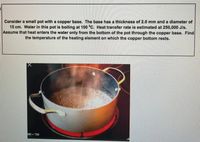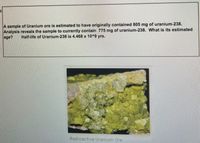
College Physics
11th Edition
ISBN: 9781305952300
Author: Raymond A. Serway, Chris Vuille
Publisher: Cengage Learning
expand_more
expand_more
format_list_bulleted
Concept explainers
Question
thumb_up100%

Transcribed Image Text:Consider a small pot with a copper base. The base has a thickness of 2.0 mm and a diameter of
15 cm. Water in this pot is boiling at 100 °C. Heat transfer rate is estimated at 250,000 J/s.
Assume that heat enters the water only from the bottom of the pot through the copper base. Find
the temperature of the heating element on which the copper bottom rests.
200 720

Transcribed Image Text:A sample of Uranium ore is estimated to have originally contained 805 mg of uranium-238.
Analysis reveals the sample to currently contain 775 mng of uranium-238. What is its estimated
age?
Half-life of Uranium-238 is 4.468 x 10^9 yrs.
Radioactive Uranium Ore.
Expert Solution
This question has been solved!
Explore an expertly crafted, step-by-step solution for a thorough understanding of key concepts.
Step by stepSolved in 3 steps with 3 images

Knowledge Booster
Learn more about
Need a deep-dive on the concept behind this application? Look no further. Learn more about this topic, physics and related others by exploring similar questions and additional content below.Similar questions
- A pot of water is boiling under one atmosphere of pressure. Assume that heat enters the pot only through its bottom, which is copper and rests on a heating element. In two minutes, the mass of water boiled away is m = 3.5 kg. The radius of the pot bottom is R = 7.5 cm and the thickness is L = 1.0 mm. What is the temperature of the heating element in contact with the pot?arrow_forwardA steel rod and an aluminium rod, with diameter 1.00 cm and length 25.0 cm are welded end to end. One end of the steel rod is placed in a large tank of boiling water at 100°C, while the far end of the aluminium rod is placed in a large tank of water at 20°C. The rods are insulated so that no heat escapes from their surface. Calculate the temperature at the joint and the rate of heat conduction through this rod.arrow_forwardTo treat a burn on his hand, a person decides to place an ice cube on the burned skin. The mass of the ice cube is 12.5 g, and its initial temperature is -12.2 °C. The water resulting from the melted ice reaches the temperature of his skin, 30.5 °C. How much heat is absorbed by the ice cube and resulting water? Assume that all of the water remains in the hand. Constants for water can be found in this table. q= Jarrow_forward
- A cylindrical metal rod with a thermal conductivity of 449.1 W / (m K) has one end at 64.6°C and the other at 4.1°C. It is 8.4 m long and has a radius of 1.1 cm. What is the rate of heat transfer through the rod?arrow_forwardAt a chemical plant where you are an engineer, a tank contains an unknown liquid. You must determine the liquids specific heat capacity. You put 0.500 kgkg of the liquid into an insulated metal cup of mass 0.200 kgkg. Initially the liquid and cup are at 20∘C∘C. You add 0.500 kgkg of water that has a temperature of 80∘C∘C. After thermal equilibrium has been reached, the final temperature of the two liquids and the cup is 58.2 ∘C∘C. You then empty the cup and repeat the experiment with the same initial temperatures, but this time with 1.00 kgkg of the unknown liquid. The final temperature is 49.4 ∘C∘C. Assume that the specific heat capacities are constant over the temperature range of the experiment and that no heat is lost to the surroundings. a,) Calculate the specific heat capacity of the liquid. b.)Calculate the specific heat capacity of the metal from which the cup is madearrow_forwardA closed box is filled with dry ice at a temperature of -83.9 °C, while the outside temperature is 26.9 °C. The box is cubical, measuring 0.350 m on a side, and the thickness of the walls is 3.80 x 10-2 m. In one day, 3.35 x 106 J of heat is conducted through the six walls. Find the thermal conductivity of the material from which the box is made. Number 30251.3 Unitsarrow_forward
- You drop an ice cube into an insulated container full of water and wait for the ice cube to completely melt. The ice cube initially has a mass of 80.0 g and a temperature of 0°C. The water (before the ice cube is added) has a mass of 770 g and an initial temperature of 26.0°C. What is the final temperature (in °C) of the mixture? (Assume no energy is lost to the walls of the container, or to the environment.)arrow_forwardA thermally isolated container has 479 grams of water in it and a 376 gram plastic block. The water had an initial temperature of 352 K. The plastic had an initial temperature of 300 K. The plastic and water reach an equilibrium temperature of 342 K. Water has a specific heat of 4.182 J/(gram K). What is the specific heat of the plastic block in J/(gram K)?arrow_forwardA 0.200-kg mass of metal with a specific heat of 1255.8 J/kg-°C, initially at 90°C, is placed in a 0.500-kg calorimeter, with a specific heat of 418.6 J/kg-°C, initially at 20°C. The calorimeter is filled with 0.100 kg of water, initially at 20°C. The specific heat of water is 4186 J/kg-°C. What is the final temperature once the combination of metal, calorimeter, and water reach equilibrium? O 70°C 40°C 60°C O 50°Carrow_forward
- To defog the rear window of an automobile, a very thin transparent heating element is attached to the inner surface of the window. A uniform heat flux of 1300 W/m2 is provided to the heating element for defogging a rear window with thickness of 5 mm. The interior temperature of the automobile is 22°C and the convection heat transfer coefficient is 15 W/m2·K. The outside ambient temperature is -5°C and the convection heat transfer coefficient is 100 W/m2·K. If the thermal conductivity of the window is 1.2 W/m·K, determine the inner surface temperature of the window.arrow_forward7. (a) What is the heat capacity of a system consisting of a 0.3600 kg brass cup filled with 0.05000 kg of water? in kJ/K (b) What is the heat capacity of a system consisting of 7.700 kg of water in a 0.8800 kg aluminum bucket? in kJ/karrow_forwardA styrofoam container used as a picnic cooler contains a block of ice at 0°C. If 564 g of ice melts in 1 hour, how much heat energy per second is passing through the walls of the container? The heat of fusion of ice is 3.33 x 10° J/kg. Answer in units of W.arrow_forward
arrow_back_ios
SEE MORE QUESTIONS
arrow_forward_ios
Recommended textbooks for you
 College PhysicsPhysicsISBN:9781305952300Author:Raymond A. Serway, Chris VuillePublisher:Cengage Learning
College PhysicsPhysicsISBN:9781305952300Author:Raymond A. Serway, Chris VuillePublisher:Cengage Learning University Physics (14th Edition)PhysicsISBN:9780133969290Author:Hugh D. Young, Roger A. FreedmanPublisher:PEARSON
University Physics (14th Edition)PhysicsISBN:9780133969290Author:Hugh D. Young, Roger A. FreedmanPublisher:PEARSON Introduction To Quantum MechanicsPhysicsISBN:9781107189638Author:Griffiths, David J., Schroeter, Darrell F.Publisher:Cambridge University Press
Introduction To Quantum MechanicsPhysicsISBN:9781107189638Author:Griffiths, David J., Schroeter, Darrell F.Publisher:Cambridge University Press Physics for Scientists and EngineersPhysicsISBN:9781337553278Author:Raymond A. Serway, John W. JewettPublisher:Cengage Learning
Physics for Scientists and EngineersPhysicsISBN:9781337553278Author:Raymond A. Serway, John W. JewettPublisher:Cengage Learning Lecture- Tutorials for Introductory AstronomyPhysicsISBN:9780321820464Author:Edward E. Prather, Tim P. Slater, Jeff P. Adams, Gina BrissendenPublisher:Addison-Wesley
Lecture- Tutorials for Introductory AstronomyPhysicsISBN:9780321820464Author:Edward E. Prather, Tim P. Slater, Jeff P. Adams, Gina BrissendenPublisher:Addison-Wesley College Physics: A Strategic Approach (4th Editio...PhysicsISBN:9780134609034Author:Randall D. Knight (Professor Emeritus), Brian Jones, Stuart FieldPublisher:PEARSON
College Physics: A Strategic Approach (4th Editio...PhysicsISBN:9780134609034Author:Randall D. Knight (Professor Emeritus), Brian Jones, Stuart FieldPublisher:PEARSON

College Physics
Physics
ISBN:9781305952300
Author:Raymond A. Serway, Chris Vuille
Publisher:Cengage Learning

University Physics (14th Edition)
Physics
ISBN:9780133969290
Author:Hugh D. Young, Roger A. Freedman
Publisher:PEARSON

Introduction To Quantum Mechanics
Physics
ISBN:9781107189638
Author:Griffiths, David J., Schroeter, Darrell F.
Publisher:Cambridge University Press

Physics for Scientists and Engineers
Physics
ISBN:9781337553278
Author:Raymond A. Serway, John W. Jewett
Publisher:Cengage Learning

Lecture- Tutorials for Introductory Astronomy
Physics
ISBN:9780321820464
Author:Edward E. Prather, Tim P. Slater, Jeff P. Adams, Gina Brissenden
Publisher:Addison-Wesley

College Physics: A Strategic Approach (4th Editio...
Physics
ISBN:9780134609034
Author:Randall D. Knight (Professor Emeritus), Brian Jones, Stuart Field
Publisher:PEARSON